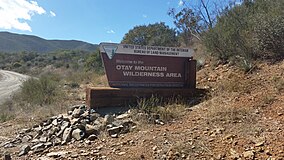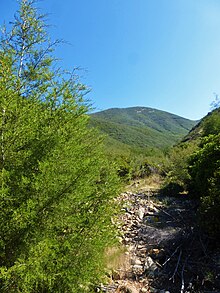Otay Mountain Wilderness
| Otay Mountain Wilderness | |
|---|---|
IUCN category V (protected landscape/seascape) | |
 BLM sign on Otay Mountain Truck Trail | |
| Location | San Diego County, United States |
| Nearest city | Otay Mesa |
| Coordinates | 32°35′40″N 116°50′40″W / 32.59444°N 116.84444°W |
| Area | 16,885 acres (6,833 ha)[1] |
| Established | 1999 |
| Governing body | Bureau of Land Management[1][2] |

The Otay Mountain Wilderness is a U.S. wilderness area in San Diego County, California, 12 miles east of the community of Otay Mesa and just north of the Mexico–United States border. Some parts of the wilderness area rise quickly from sea level, reaching a peak of just over 3,500 feet (1,100 m) at the summit of Otay Mountain.[3]
Wilderness status was conferred on October 7, 1998, effectively preserving 18,500 acres under protection of the Wilderness Act, a component of the National Wilderness Preservation System.[4] The legislation was signed by President Bill Clinton[5]: 306 on December 11, 1999.[6] The wilderness is managed by the Bureau of Land Management.
Geography
[edit]The wilderness lies in the San Ysidro Mountains,[3] of which Otay Mountain is the highest summit at 3,566 feet (1,087 m).[7] The mountain, and its immediate surroundings, are extremely rugged and include steep, often precipitous, canyon walls and hills.[8]
The public lands within the Otay Mountain Wilderness are one of the last remaining pristine locations in western San Diego County. Adjacent to the Mexican border, it is internationally known for its diversity of unique and sensitive plants. The area plays a critical role in San Diego's multi-species conservation plan.[4]: 306
Natural history
[edit]
The San Ysidro Mountains are remnants of a chain of ancient volcanoes from which meta-volcanic soils form, sustaining a diverse chaparral community dominated by chamise (Adenostoma fasciculatum),[9] mixed chaparral and coastal sagebrush habitats.[10]
Flora
[edit]The world's largest stand of Tecate cypress (Cupressus forbesii) are found at the Otay Mountain Wilderness, as are at least 15 plant species that are candidates for federal listing as threatened or endangered species. In all 37 plant species found on Otay Mountain are listed as sensitive by the California Native Plant Society, at least five, including the Tecate cypress, occur only on Otay Mountain or in the immediate area.[10]
Particularly important species include:[9]
- Cleveland's monkeyflower (Mimulus clevelandii)
- Mexican flannelbush (Fremontodendron mexicanum)
- Otay Mountain lotus (Lotus crassifolius var. otayensis)
- Southern mountain misery (Chamaebatia australis)
- San Miguel savory (Clinopodium chandleri)
- Gander's pitcher sage (Lepechinia ganderi)

- San Diego thorn-mint (Acanthomintha ilicifolia)
- Parish's button-celery (Eryngium aristulatum var. parishii)
- Otay tarweed (Hemizonia conjugens)
- Dehesa bear-grass (Nolina interrata)
- Dunn's mariposa (Calochortus dunnii)
- Slender-pod squaw cabbage (Caulanthus stenocarpus)
- Mexican fremontia (Fremontodendron mexicanum)
- Gander butterweed (Senecio ganderi)
Fauna
[edit]
The diversity of habitats within the wilderness area maintains a variety of indigenous fauna, including a number of rare or endangered species. The most numerous large animal is the mule deer.[4]: 11–12]
Species of special concern on Otay Mountain include:[10]

Endangered species
[edit]- Bighorn sheep[4]: 11–12]
- Quino checkerspot butterfly[12]
- The arroyo toad, resident of the Tijuana river, is affected by erosion occurring on the Tijuana watershed, within the wilderness area, which causes silting of its habitat.[12]
Border wall
[edit]In the mid 1990s, as part of Operation Gatekeeper,[13] Department of Homeland Security contractors began to build a border wall,[14] and associated access roads.[15] The initial phase of wall building extended from San Diego only as far as the foothills of Otay Mountain.[16]
An environmental impact statement carried out prior to a waiver of an environmental law, required to allow construction within the wilderness area, concluded that the work on the border wall would have long-term impacts on plant, animal and water courses within the area. Grading and construction of roads in the wilderness area would result in removal of layers of topsoil and delicate, intertwined root systems that protect dry chaparral habitat from erosion.[12] The wall itself disrupts the ability of migratory animals, like the javelina, to roam freely across its natural range.[17] In December 2008 work began to continue the wall's progress through the wilderness area,[17] under the auspices of the Secure Fence Act of 2006.
See also
[edit]- List of U.S. Wilderness Areas
- Mexico–United States barrier
- National Landscape Conservation System
- Wilderness Act
Notes
[edit]IUCN category obtained from Protected Planet: Otay Mountain State Ecological Reserve entry. Retrieved March 7, 2015.
References
[edit]- ^ a b "Otay Mountain Wilderness, CA". recreation.gov. March 2015. Archived from the original on April 2, 2015. Retrieved March 7, 2015.
- ^ Backpacker, (May 2001) Vol. 29 No. 195 page 82 Archived 2022-09-02 at the Wayback Machine Active Interest Media, Inc. ISSN 0277-867X Retrieved March 7, 2015
- ^ a b Longmire, S. (2014) Border Insecurity: Why Big Money, Fences, and Drones Aren't Making Us Safer page 62 Archived 2015-04-02 at the Wayback Machine Palgrave Macmillan. ISBN 1137443731 Retrieved March 7, 2015
- ^ a b c d e Congress (U.S.) (2004) Congressional Record, V. 144, Pt. 17, October 7, 1998 to October 9, 1998, page 24176 Archived 2015-04-02 at the Wayback Machine Government Printing Office. ISBN 0160680832 Retrieved March 7, 2015
- ^ Schad, J. (2007) Afoot and Afield: San Diego County: A Comprehensive Hiking Guide Archived 2015-04-02 at the Wayback Machine Wilderness Press. ISBN 0899974287 Retrieved March 7, 2015
- ^ Harmon, D., McManamon, F.P. & Pitcaithley, D.T. (2006) The Antiquities Act: A Century of American Archaeology, Historic Preservation, and Nature Conservation page 127 Archived 2015-04-02 at the Wayback Machine University of Arizona Press. ISBN 0816525617 Retrieved March 7, 2015
- ^ "Otay Mountain information". summitpost.org. July 2010. Archived from the original on December 11, 2014. Retrieved March 7, 2015.
- ^ Arnold, K.R. (Ed.) (2011) Anti-Immigration in the United States: A Historical Encyclopedia page 690 Archived 2015-04-02 at the Wayback Machine ABC-CLIO. ISBN 0313375224 Retrieved March 7, 2015
- ^ a b Faber, P.M. (2005) California's Wild Gardens: A Guide to Favorite Botanical Sites page 194 Archived 2015-04-02 at the Wayback Machine University of California Press. ISBN 0520240316 Retrieved March 7, 2015
- ^ a b c United States. Bureau of Land Management. California State Office California Wild!, Fish & wildlife 2000 series publication page 40-41 Archived 2015-04-02 at the Wayback Machine The Bureau. Retrieved March 7, 2015
- ^ a b United States. Bureau of Land Management. California Desert District (1985) Preliminary Wilderness Recommendations for the Western Counties Wilderness Study (western San Diego and Western Riverside Counties), California ; Prepared by Department of the Interior, Bureau of Land Management, California Desert District Appendix A Archived 2015-04-02 at the Wayback Machine The District. Retrieved March 7, 2015
- ^ a b c "Otay Mountain Wilderness". attheedges.com. March 7, 2015. Archived from the original on March 29, 2015. Retrieved March 7, 2015.
- ^ Eastman, C.L.S (2008) Civil Society on the Line: Examining the Relationship Between Media and Activist Groups Along the Arizona/Sonora Border page 93-94 Archived 2015-04-02 at the Wayback Machine ProQuest. ISBN 0549508554 Retrieved March 7, 2015
- ^ Azaransky, S. (2013) Religion and Politics in America's Borderlands page 169 Archived 2015-04-02 at the Wayback Machine Lexington Books. ISBN 0739178636 Retrieved March 7, 2015
- ^ Adamson, J. & Ruffin, K.N. (Eds)(2013) American Studies, Ecocriticism, and Citizenship: Thinking and Acting in the Local and Global Commons page 152 Archived 2015-04-02 at the Wayback Machine Routledge. ISBN 1135078831 Retrieved March 7, 2015
- ^ Tuer, D. (2005) Mining the Media Archive: Essays on Art, Technology, and Cultural Resistance page 162 Archived 2015-04-02 at the Wayback Machine YYZ Books. ISBN 0920397352 Retrieved March 7, 2015
- ^ a b "Bulldozing Nature". utsandiego.com. February 2009. Archived from the original on September 2, 2022. Retrieved March 7, 2015.

